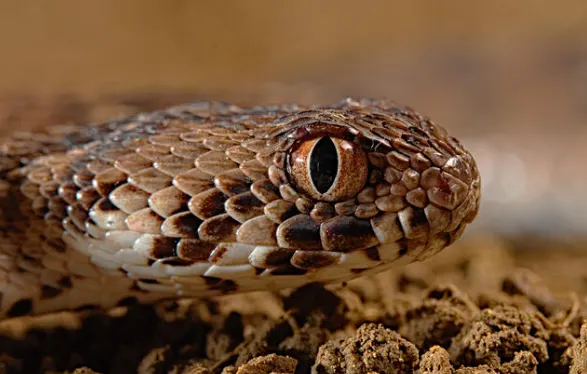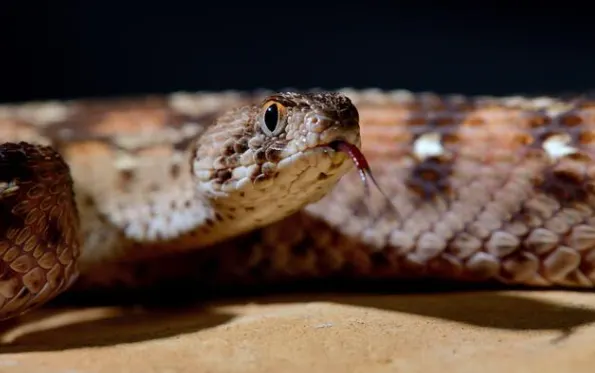The carpet viper, also known as the saw-scaled viper, is a small but deadly snake that inhabits the arid regions of Africa, the Middle East, India, Sri Lanka, and Pakistan. Despite its unassuming appearance and relatively small size, this snake is responsible for more human fatalities due to snakebites than any other species. With its aggressive nature, potent venom, and widespread distribution, the carpet viper is a creature that demands respect and caution.

Table of Contents
Overview and Classification
The carpet viper belongs to the genus Echis, which is derived from the Greek word for “viper.” This genus includes 12 recognized species, each with its unique characteristics and habitats. The scientific classification of the carpet viper is as follows:
- Kingdom: Animalia
- Phylum: Chordata
- Class: Reptilia
- Order: Squamata
- Family: Viperidae
- Genus: Echis
Among the species in this genus, some of the most well-known include Echis carinatus (saw-scaled viper), Echis coloratus (painted carpet viper), and Echis ocellatus (ocellated carpet viper).
Physical Characteristics
Carpet vipers are relatively small snakes, typically ranging from 12 to 35 inches in length. Their coloration is usually earth-toned, with shades of brown, gray, and orange that help them blend into their arid environments. The scales on their bodies are keeled, giving them a rough texture, and the scales on their sides are serrated, contributing to their alternative name, the saw-scaled viper.
These vipers have a distinctive appearance, with a small, pear-shaped head, large round eyes, and a short tail. Despite their small size and drab colors, carpet vipers are striking in their own right, particularly in their defensive behavior, which involves rubbing their serrated scales together to produce a “sizzling” sound as a warning to potential threats.
Distribution and Habitat
Carpet vipers are found across a wide range of habitats in Africa, the Middle East, and parts of South Asia. Their preferred environments vary depending on the species but generally include arid and semi-arid regions such as deserts, dry savannas, and rocky outcrops. For example, Echis carinatus is commonly found in the deserts of India and Pakistan, while Echis coloratus inhabits the rocky deserts of the Middle East.
The adaptability of carpet vipers to different environments is one of the reasons for their widespread distribution and success as a species. These snakes are solitary creatures, often found hiding under rocks, in burrows, or among vegetation during the day, emerging at dusk or during humid weather to hunt.
Diet and Hunting Behavior
Carpet vipers are carnivorous predators with a diverse diet that includes insects, slugs, worms, scorpions, reptiles, amphibians, birds, and small mammals. They are opportunistic feeders, preying on any animal they can overpower and consume. Their hunting strategy typically involves lying in wait for prey to pass by, at which point the viper strikes with remarkable speed and accuracy, delivering a venomous bite that quickly incapacitates its victim.
Like other snakes, carpet vipers use their forked tongues to detect chemical signals in the environment, which helps them locate prey. They are also sensitive to vibrations, allowing them to detect the movement of potential prey even when they cannot see it.
Venom and Danger to Humans
The venom of carpet vipers is particularly potent and is responsible for more snakebite fatalities than any other snake species. This venom contains a combination of neurotoxins, cytotoxins, hemotoxins, and cardiotoxins, making it extremely dangerous. The venom attacks multiple bodily systems, including the nervous system, cardiovascular system, blood, and cells. Symptoms of a bite include uncontrolled bleeding, organ failure, and, if untreated, death.
One of the reasons carpet vipers are so dangerous is their aggressive nature. They are quick to strike when threatened and often live in close proximity to human populations, particularly in rural areas where access to medical care is limited. Their small size and earth-toned coloration make them difficult to spot, increasing the likelihood of accidental encounters.
Reproduction and Lifespan
Carpet vipers breed during the winter, with females typically laying between 3 and 23 eggs, depending on the species. However, some species, such as Echis carinatus in India, give birth to live young. In these cases, the eggs hatch inside the female’s body, and the hatchlings are born fully formed.
The lifespan of a carpet viper is relatively long for a snake, with individuals living up to 24 years in the wild. This longevity, combined with their reproductive success, contributes to the abundance of carpet vipers in their natural habitats.
Interaction with Humans
Due to their aggressive nature and potent venom, carpet vipers have a complex relationship with humans. On the one hand, they are feared and respected for the danger they pose, especially in regions where snakebite deaths are common. On the other hand, they play an important role in controlling populations of pests such as rodents, which can benefit agricultural communities.
In some cultures, the venom of carpet vipers has been studied for its potential medical applications. For example, echistatin, a compound derived from Echis carinatus venom, is used as an anticoagulant in medical treatments.

Conservation Status
Despite their lethal reputation, most species of carpet vipers are not considered endangered. The IUCN Red List classifies many of them as being of “Least Concern” due to their widespread distribution and relatively stable populations. However, for some species, such as the Mali carpet viper, there is insufficient data to accurately assess their conservation status.
The carpet viper is a fascinating and formidable snake that exemplifies the power of nature’s smaller creatures. With its aggressive behavior, potent venom, and adaptability to harsh environments, it has earned a reputation as one of the most dangerous snakes in the world. However, it is also a vital part of its ecosystem, helping to control pest populations and contributing to biodiversity in the regions it inhabits. As with all wildlife, understanding and respecting the carpet viper is key to coexisting safely with this remarkable snake.
- Enchi Ball Python: A Unique and Stunning Morph of Python regius - March 27, 2025
- Emerald Tree Monitor: The Enigmatic Green Guardian of the Rainforest - March 26, 2025
- The Egyptian Cobra (Naja haje): A Fascinating Serpent - March 25, 2025
